Evaluation of the Performance of Gabion Walls as a High-Energy Rockfall Protection System Using 3D Numerical Analysis: A Case Study
Abstract
:1. Introduction
2. Geology of the Study Area
3. Field Studies and Measurements
3.1. Rockfall Potential of the Study Area
3.2. Creating a Three-Dimensional Model
4. Results
4.1. Rockfall Analysis
4.2. Performance Analysis for Gabion Wall
4.2.1. Outside Stability Failure
4.2.2. Inside Stability Failure
4.3. Explicit Analysis
5. Conclusions
Author Contributions
Funding
Data Availability Statement
Conflicts of Interest
References
- Şen, Ö.L.; Bozkurt, D.; Göktürk, O.M.; Dündar, B.; Altürk, B. Türkiye’de İklim Değişikliği ve Olası Etkileri, 3. Taşkın Sempozyumu 2017, 29, 30. [Google Scholar]
- Ersoy, H.; Kaya, A.; Angın, Z.; Dağ, S. 2D and 3D Numerical Simulations of a Reinforced Landslide: A Case Study in NE Turkey. J. Earth Syst. Sci. 2020, 129, 82. [Google Scholar] [CrossRef]
- Gökçe, O.; Ozden, S.; Demir, A. Türkiye’de Afetlerin Mekansal ve Istatistiksel Dağilimi Afet Bilgileri Envanteri; Bayındırlık ve İskan Bakanlığı: Ankara, Turkey, 2008. (In Turkish) [Google Scholar]
- Karahan, M.; Ersoy, H.; Akgun, A. A 3D Numerical Simulation-Based Methodology for Assessment of Landslide-Generated Impulse Waves: A Case Study of The Tersun Dam Reservoir (NE Turkey). Landslides 2020, 17, 2777–2794. [Google Scholar] [CrossRef]
- Nasery, M.M.; Coşgun, S.İ.; Temel, B.A. Multi-Scenario Analysis of Rockfall Hazard for a Historical Vaulted Masonry Building in Sumela Monastery. Int. J. Archit. Herit. 2022, 17, 1876–1904. [Google Scholar] [CrossRef]
- Sünnetçi, M.O.; Ersoy, H.; Ersoy, A.F. Numerical and Back Analysis-Based Methodology for Support Design of Cut Slopes at The Turkish—Georgian Border (NE Turkey). J. Mt. Sci. 2021, 18, 1678–1695. [Google Scholar] [CrossRef]
- Meng, X.; Jiang, Q.; Han, J.; Liu, R. Experimental Investigation of Geogrid-Reinforced Sand Cushions for Rock Sheds Against Rockfall Impact. Transp. Geotech. 2022, 33, 100717. [Google Scholar] [CrossRef]
- Perera, J.S.; Lam, N.; Disfani, M.M.; Gad, E. Experimental and Analytical Investigation of a RC Wall with a Gabion Cushion Subjected to Boulder Impact. Int. J. Impact Eng. 2021, 151, 103823. [Google Scholar] [CrossRef]
- Lambert, S.; Kister, B. Efficiency Assessment of Existing Rockfall Protection Embankments Based on An Impact Strength Criterion. Eng. Geol. 2008, 243, 1–9. [Google Scholar] [CrossRef]
- Gao, Z.; Al-Budairi, H.; Steel, A. Experimental Testing of Low-Energy Rockfall Catch Fence Meshes. J. Rock Mech. Geotech. Eng. 2018, 10, 798–804. [Google Scholar] [CrossRef]
- Zhao, P.; Xie, L.; Zhang, Y. Experimental Study of Rock-Sheds Constructed with Pe Fibres and Composite Cushion Against Rockfall Impacts. Eng. Struct. 2018, 177, 175–189. [Google Scholar] [CrossRef]
- Plassiard, J.P.; Donze, F.V. Optimizing the Design of Rockfall Embankments with a Discrete Element Method. Eng. Struct. 2010, 32, 3817–3826. [Google Scholar] [CrossRef]
- Korini, O.; Bost, M.; Rajot, J.P.; Bennani, Y.; Freitag, N. The Influence of Geosynthetics Design on The Behavior of Reinforced Soil Embankments Subjected to Rockfall Impacts. Eng. Geol. 2021, 286, 106054. [Google Scholar] [CrossRef]
- Akın, M.; Dinçer, İ.; Orhan, A.; Ok, A.Ö.; Akın, M.K.; Topal, T. Evaluation of the Performance of a Rockfall Ditch by 3-Dimensional Rockfall Analyses: Akköy (Ürgüp) Case. J. Geol. Eng. 2019, 43, 211–232. [Google Scholar] [CrossRef]
- RocPro3D. RocPro3D Software. 2014. Available online: https://www.linkedin.com/company/rocpro3d/ (accessed on 10 January 2024).
- Taga, H.; Zorlu, K. Assessment of Rockfall Hazard on Steep Slopes: Ermenek (Karaman, Turkey). Yerbilimleri 2017, 38, 161–178. Available online: https://dergipark.org.tr/tr/pub/yerbilimleri/issue/39227/461916 (accessed on 10 January 2024).
- Topal, T.; Akın, M.; Özden, U.A. Assessment of Rockfall Hazard Around Afyon Castle, Turkey. Environ. Earth Sci. 2007, 53, 191–200. [Google Scholar] [CrossRef]
- Çelik, M.A.; Gülersoy, A.E. Evaluation of Rock Fall Risk in Kilis (Turkey) City by Using GIS and Remote Sensing. Int. J. Comput. Exp. Sci. Eng. 2017, 3, 1–4. Available online: https://dergipark.org.tr/tr/download/article-file/351883 (accessed on 10 January 2024).
- San, N.E.; Topal, T.; Akın, M.K. Rockfall Hazard Assessment Around Ankara Citadel (Turkey) Using Rockfall Analyses and Hazard Rating System. Geotech. Geol. Eng. 2020, 38, 3831–3851. [Google Scholar] [CrossRef]
- Keskin, B.; Bacak, G.; Bilir, M.E.; Geniş, M. Investigation of Rockfall Potential of Zonguldak-Kilimli Roadway (Turkey). Arab. J. Geosci. 2020, 13, 805. [Google Scholar] [CrossRef]
- Mummadisingh, J.V.; Sengupta, A. Study of The Dynamic Performance of a Gabion Wall. Structures 2023, 50, 576–589. [Google Scholar] [CrossRef]
- Yue, M.; Qu, L.; Zhou, S.; Wu, D.; Chen, Z.; Wen, H. Dynamic Response Characteristics of Shaking Table Model Tests on The Gabion Reinforced Retaining Wall Slope under Seismic Action. Geotext. Geomembr. 2024, 52, 167–183. [Google Scholar] [CrossRef]
- Ramli, M.; Karasu, T.J.R.; Dawood, E.T. The Stability of Gabion Walls for Earth Retaining Structures. Alex. Eng. J. 2013, 52, 705–710. [Google Scholar] [CrossRef]
- Ercan, T.; Türkecan, A.; Dinçel, A.; Günay, A. Geology of Kula-Selendi (Manisa) Area. Geol. Eng. 1983, 17, 3–28. [Google Scholar]
- Hoek, E.; Bray, J.W. Rock Slope Engineering, 3rd ed.; CRC Press: London, UK, 1981. [Google Scholar]
- Hoek, E. Putting Numbers to Geology—An Engineer’s Viewpoint. Q. J. Eng. Geol. 1999, 32, 1–19. [Google Scholar] [CrossRef]
- Ulusay, R.; Gökçeoğlu, C.; Sönmez, H.; Tuncay, E. Causes, Mechanism and Environmental ımpacts of ınstabilities at Himmetoğlu Coal Mine and Possible Remedial Measures. Environ. Geol. 2001, 40, 769–786. [Google Scholar] [CrossRef]
- Kıncal, C.; Koca, M.Y. A Proposed Method for Drawing the Great Circle Representing Dip Angle and Strike Changes. Environ. Eng. Geosci. 2009, 15, 145–165. [Google Scholar] [CrossRef]
- Kliche, C.A. Rock Slope Stability; Society for Mining, Metallurgy, and Exploration, Inc.: Littleton, CO, USA, 1999. [Google Scholar]
- Kulatilake, P.H.S.W.; Wang, L.; Tang, H.; Liang, Y. Evaluation of Rock Slope Stability for Yujian River Dam Site by Kinematic and Block Theory Analyses. Comput. Geotech. 2011, 38, 846–860. [Google Scholar] [CrossRef]
- Barton, N. The Shear Strength of Rock and Rock Joints. Int. J. Rock Mech. Min. Sci. Geomech. Abstr. 1976, 13, 255–279. [Google Scholar] [CrossRef]
- Bieniawski, Z.T. Engineering Rock Mass Classification; A Wiley Interscience Publication: Chichester, UK, 1989. [Google Scholar]
- Romana, M. A Geomechanics Classification for Slopes: Slope Mass Rating. In Rock Testing and Site Characterization; Comprehensive Rock Engineering; Hudson, I., Ed.; Pergamon: Oxford, UK, 1993; Volume 3, pp. 575–600. [Google Scholar] [CrossRef]
- Romana, M.; Serón, J.B.; Montalar, E. SMR Geomechanics Classification: Application, Experience and Validation. In Proceedings of the 10th Congress of the International Society for Rock Mechanics, ISRM 2003, Sandton, South Africa, 8–12 September 2003. [Google Scholar]
- Saroglou, H.; Marinos, V.; Marinos, P.; Tsiambaos, G. Rockfall Hazard and Risk Assessment: An Example from A High Promontory at The Historical Site of Monemvasia, Greece. Nat. Hazards Earth Syst. Sci. 2012, 12, 1823–1836. [Google Scholar] [CrossRef]
- Turkey Building Earthquake Code, 2018. Ankara, Turkey. (In Turkish). Available online: https://www.resmigazete.gov.tr/eskiler/2018/03/20180318M1-2.htm (accessed on 10 January 2024).
- Bishnoi, B.L. Bearing Capacity of a Closed Jointed Rock. Ph.D. Thesis, Georgia Institute of Technology, Atlanta, GA, USA, 1968. [Google Scholar]
- Peck, R.B.; Hanson, W.E.; Thornburn, T.H. Foundation Engineering; John Wiley & Sons Inc.: New York, NY, USA, 1974. [Google Scholar]
- ISRM (International Society for Rock Mechanics). Commission on Standardization of Laboratory and Field Tests: Suggested Methods for The Quantitative Description of Discontinuities in Rock Masses. Int. J. Rock Mech. Min. Sci. Geomech. Abstr. 1978, 15, 319–368. [Google Scholar] [CrossRef]
- ISRM (International Society for Rock Mechanics). Suggested Methods for Determining Water Content, Porosity, Density, Absorption and Related Properties and Swelling and Slake Durability Index Properties. Int. J. Rock Mech. Min. Sci. Geomech. Abstr. 1979, 16, 141–156. [Google Scholar]
- ISRM (International Society for Rock Mechanics). ISRM Suggested Methods: Rock Characterization, Testing and Monitoring; Brown, E.T., Ed.; Pergamon Press: London, UK, 1981. [Google Scholar]
- ISRM (International Society for Rock Mechanics). Suggested Method for Determining Point Load Strength. Int. J. Rock Mech. Min. Sci. Geomech. Abstr. 1985, 22, 51–60. [Google Scholar] [CrossRef]
- TS-7994; Soil Retaining Structures. Properties and Guidelines for Design. Turkish Standards Institute: Ankara, Turkey, 1990.
- ANSYS. 2019, Swanson Analysis System, Pennsylvania, USA. Available online: https://www.ansys.com/ (accessed on 10 January 2024).

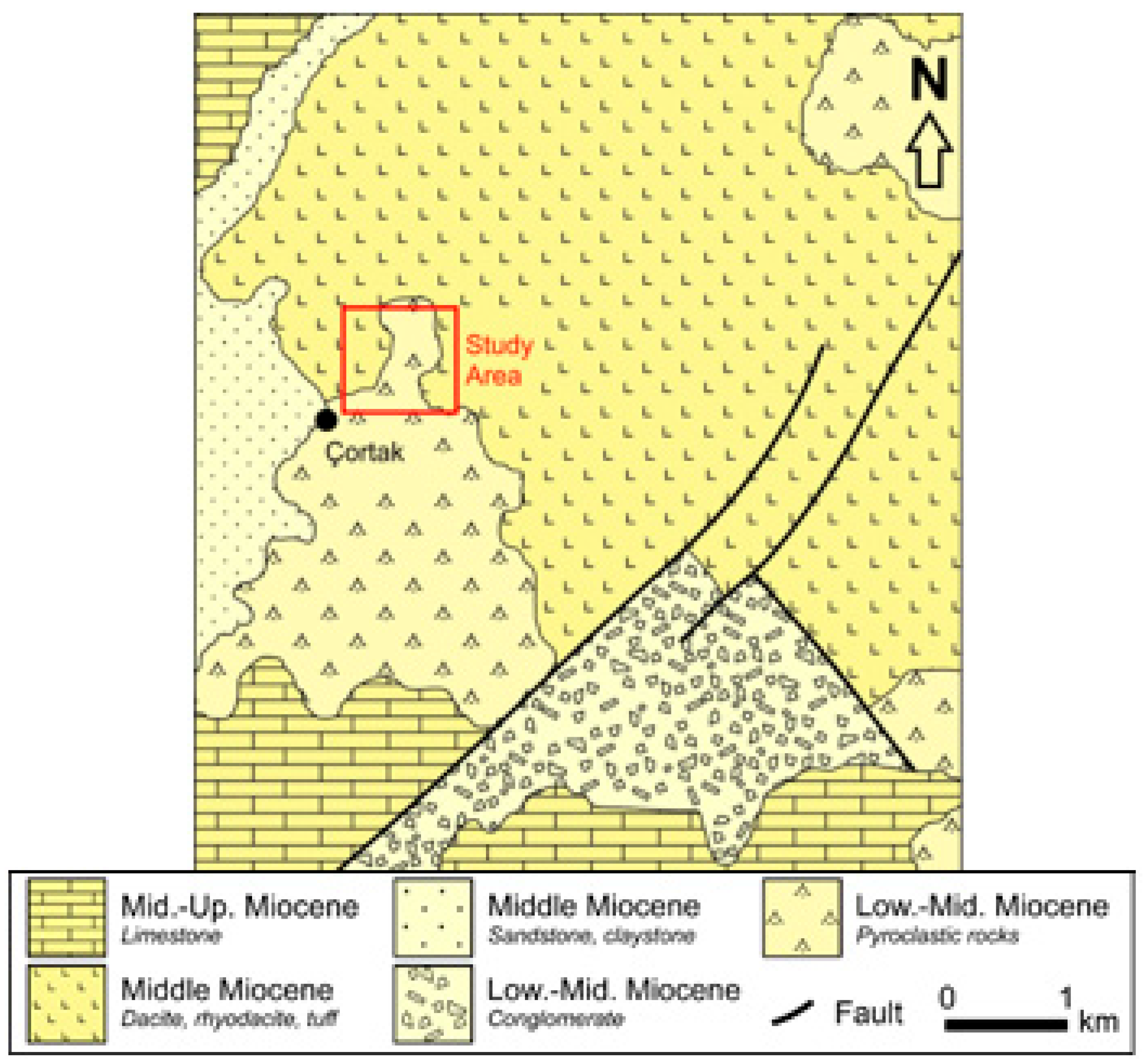



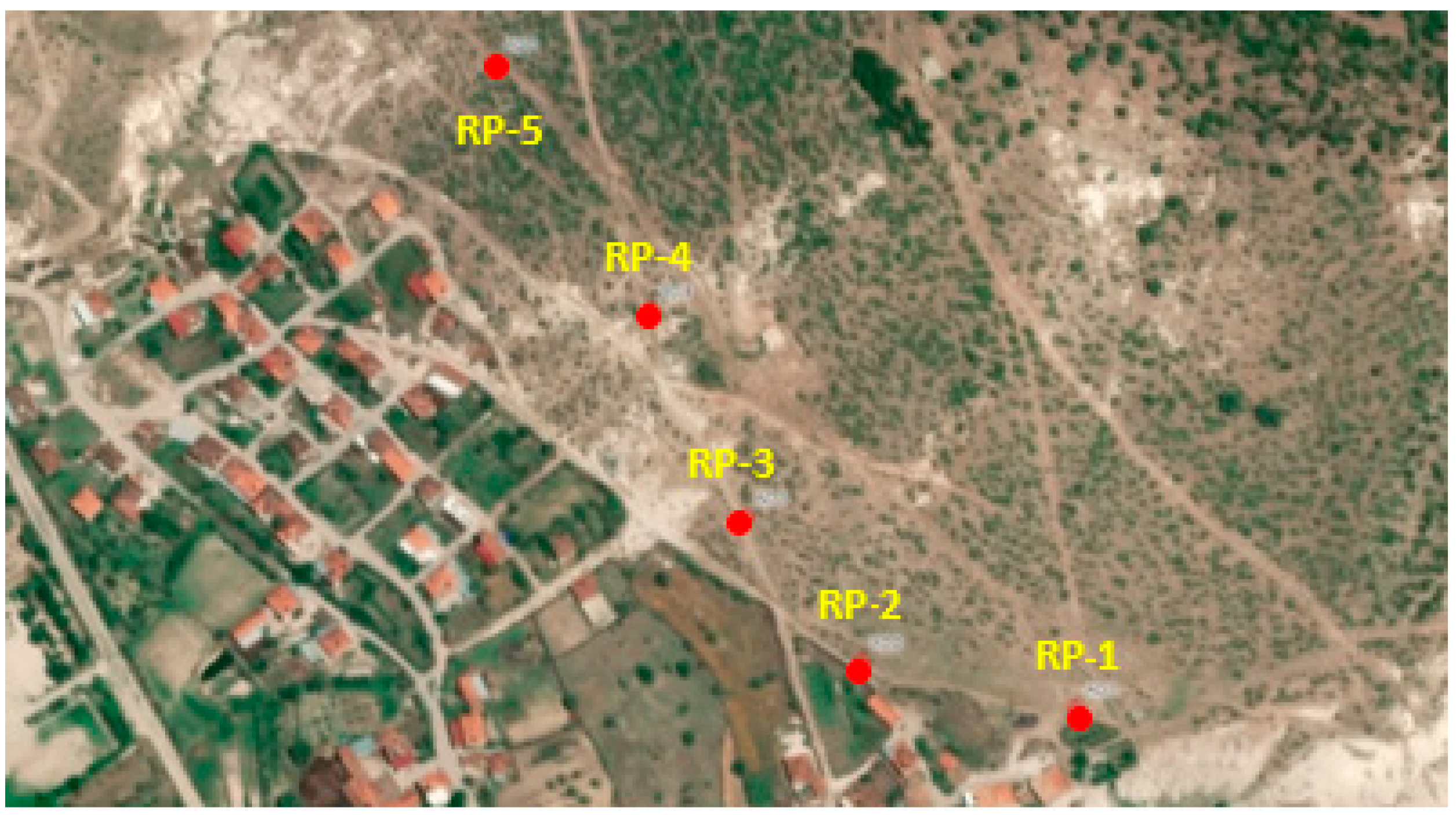
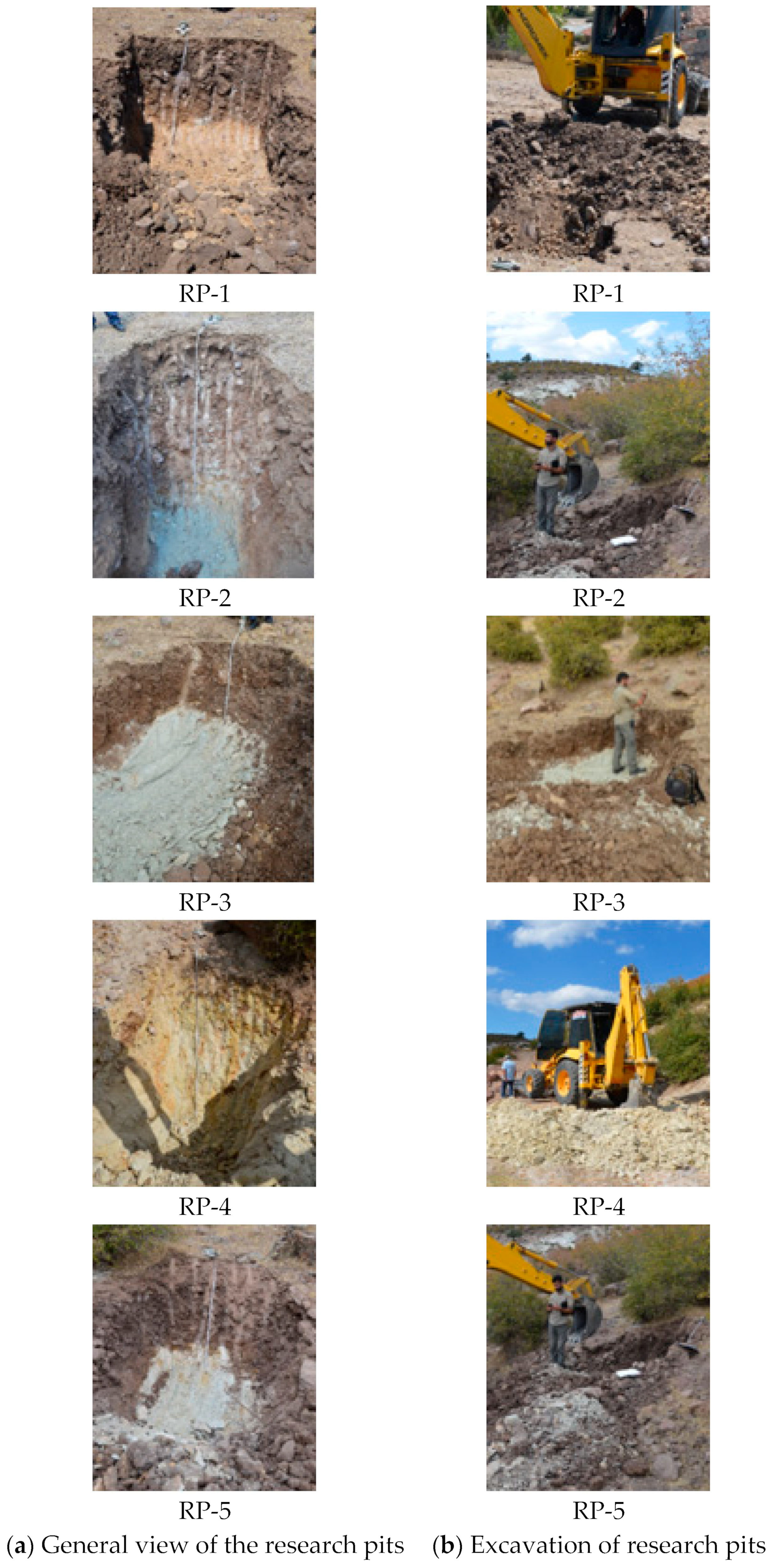

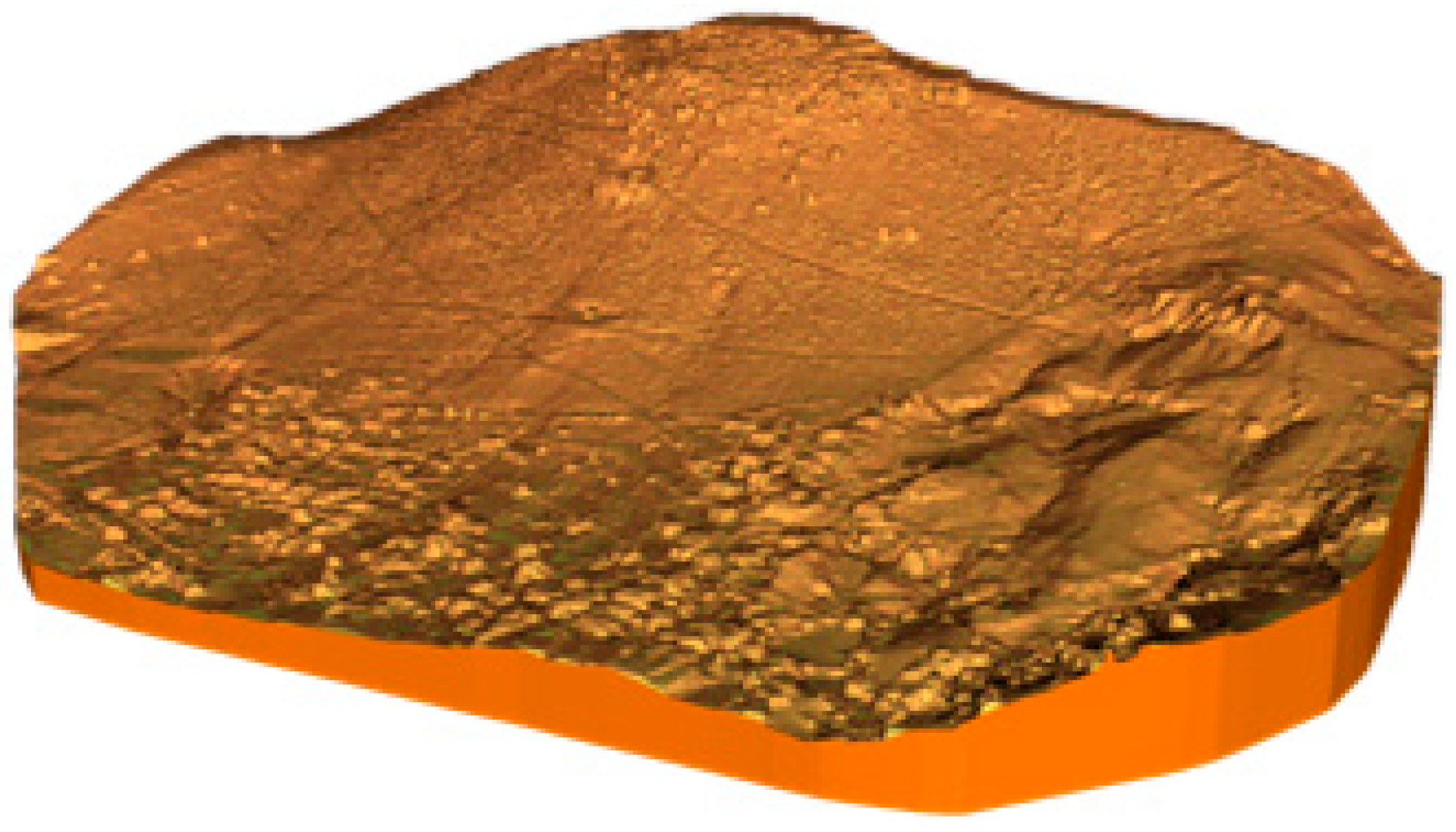
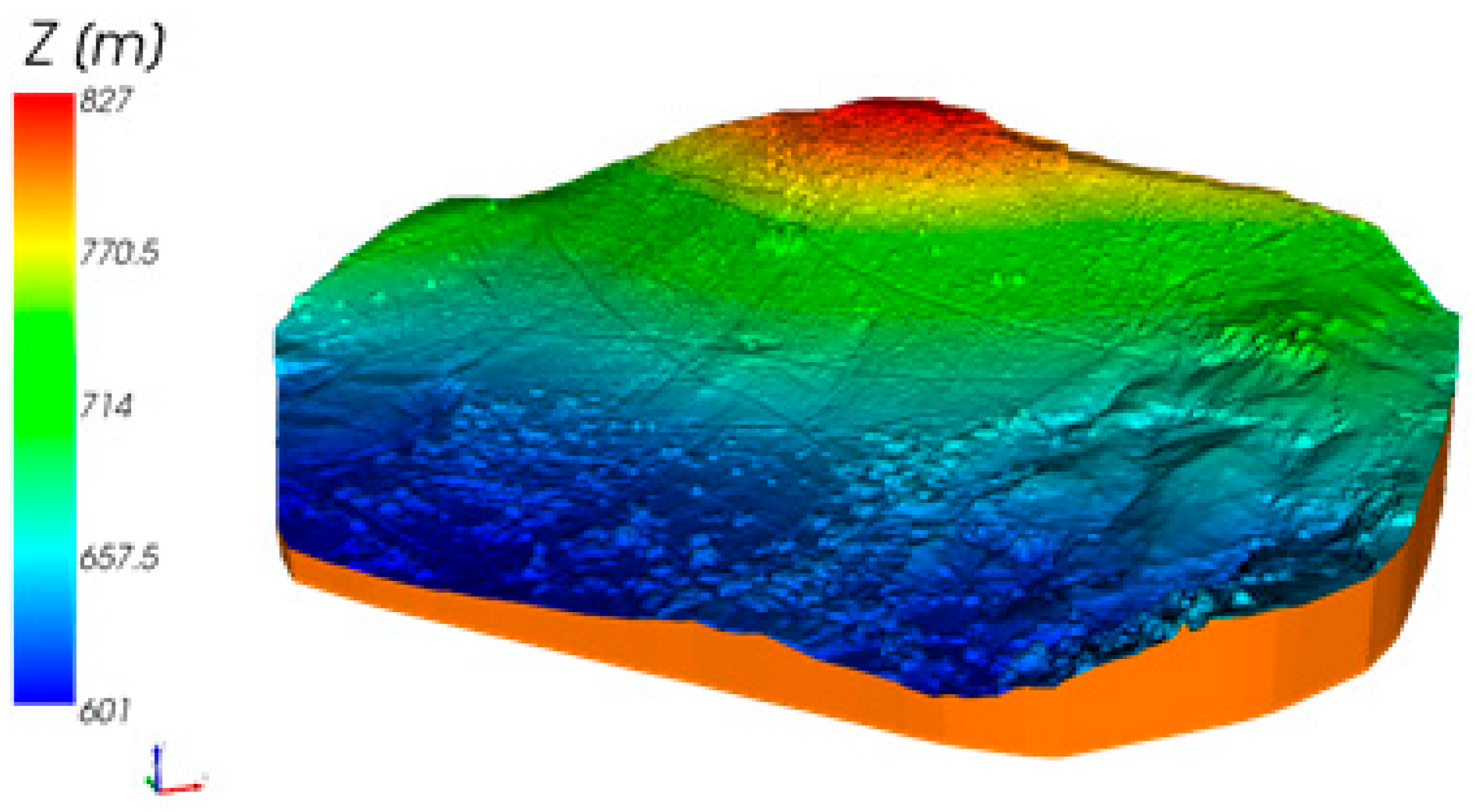
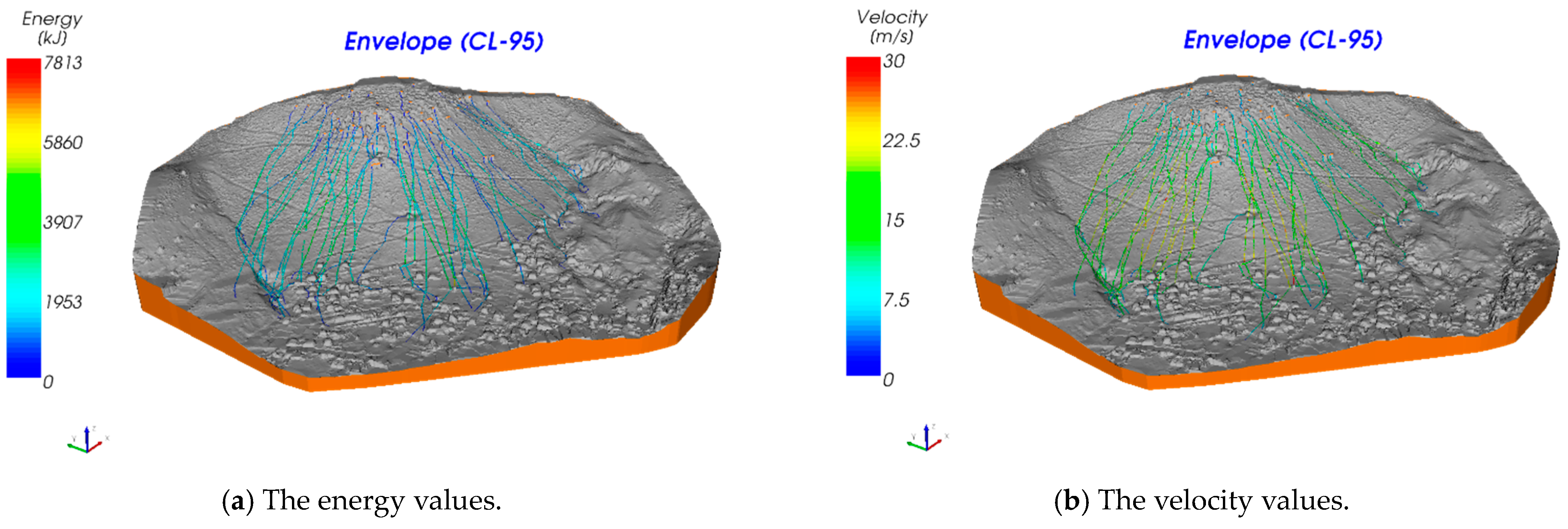

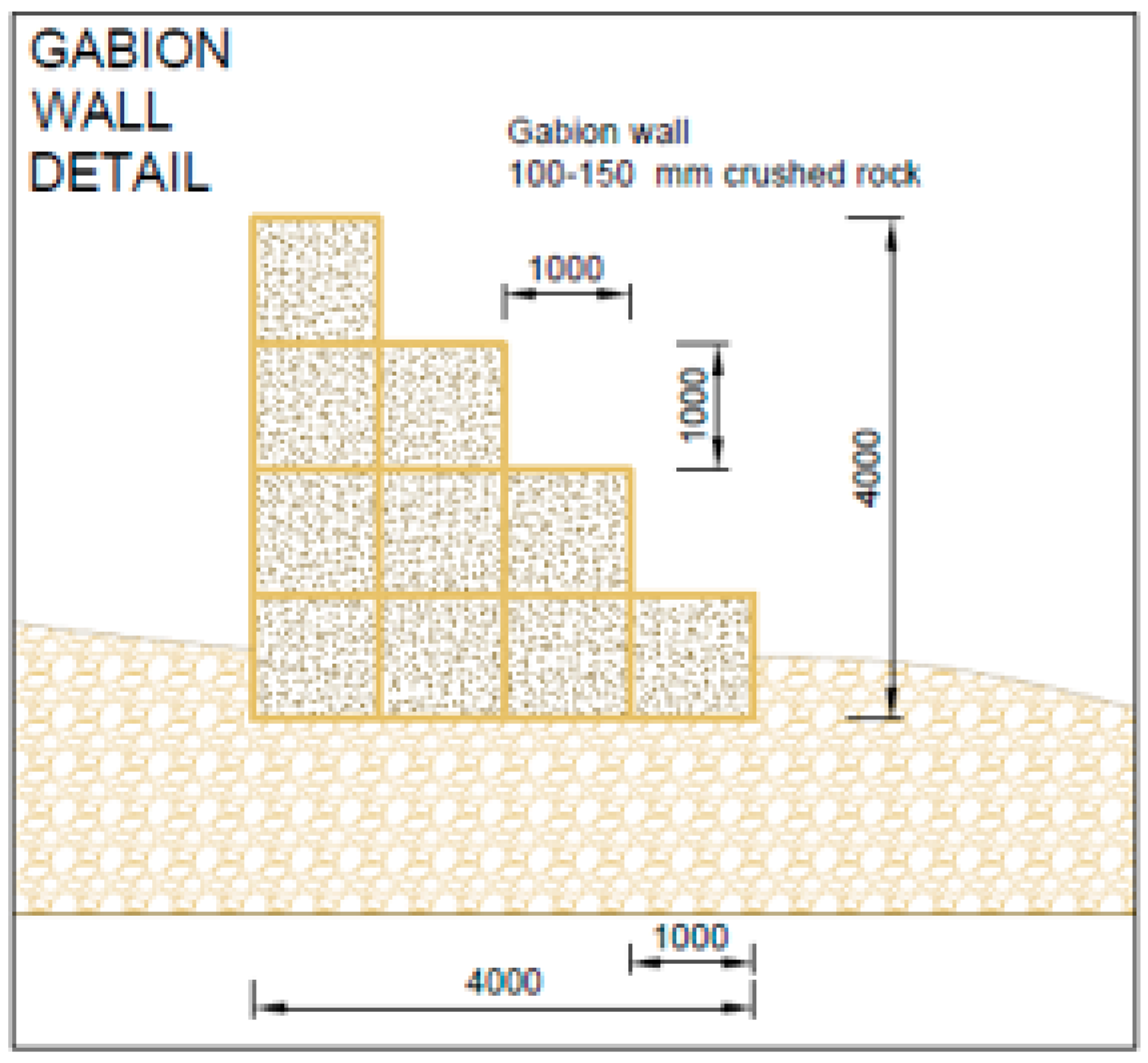


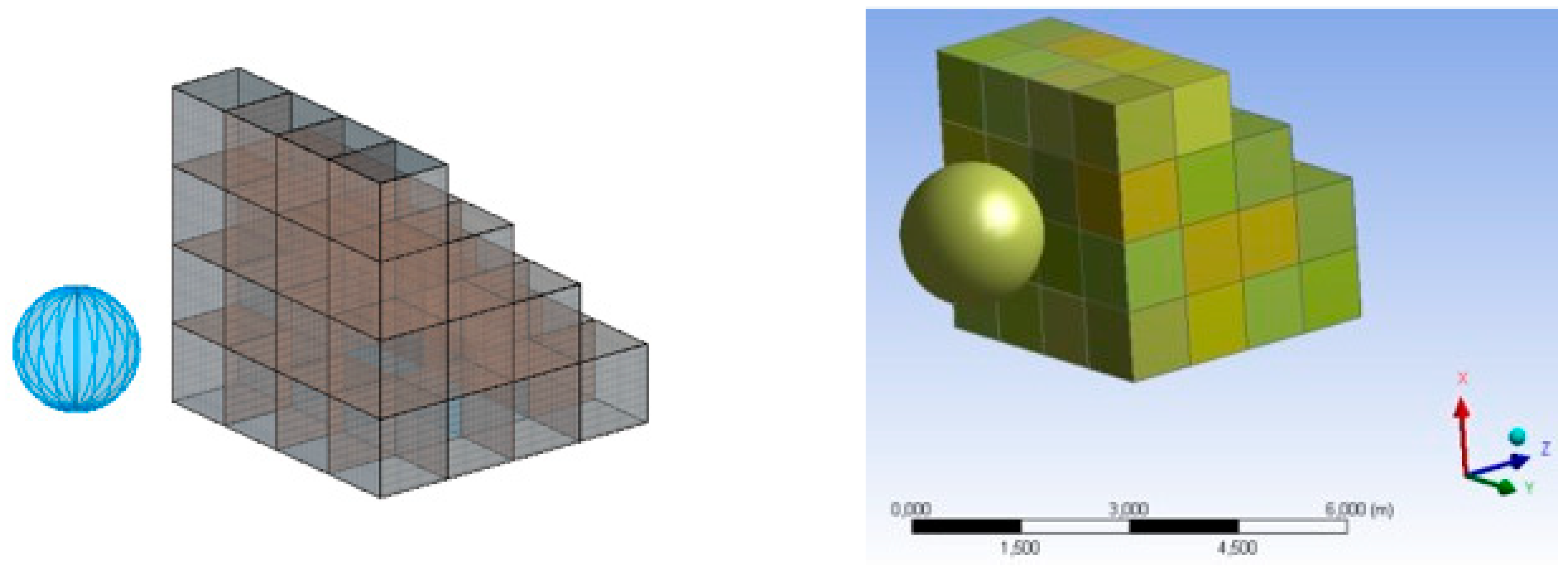

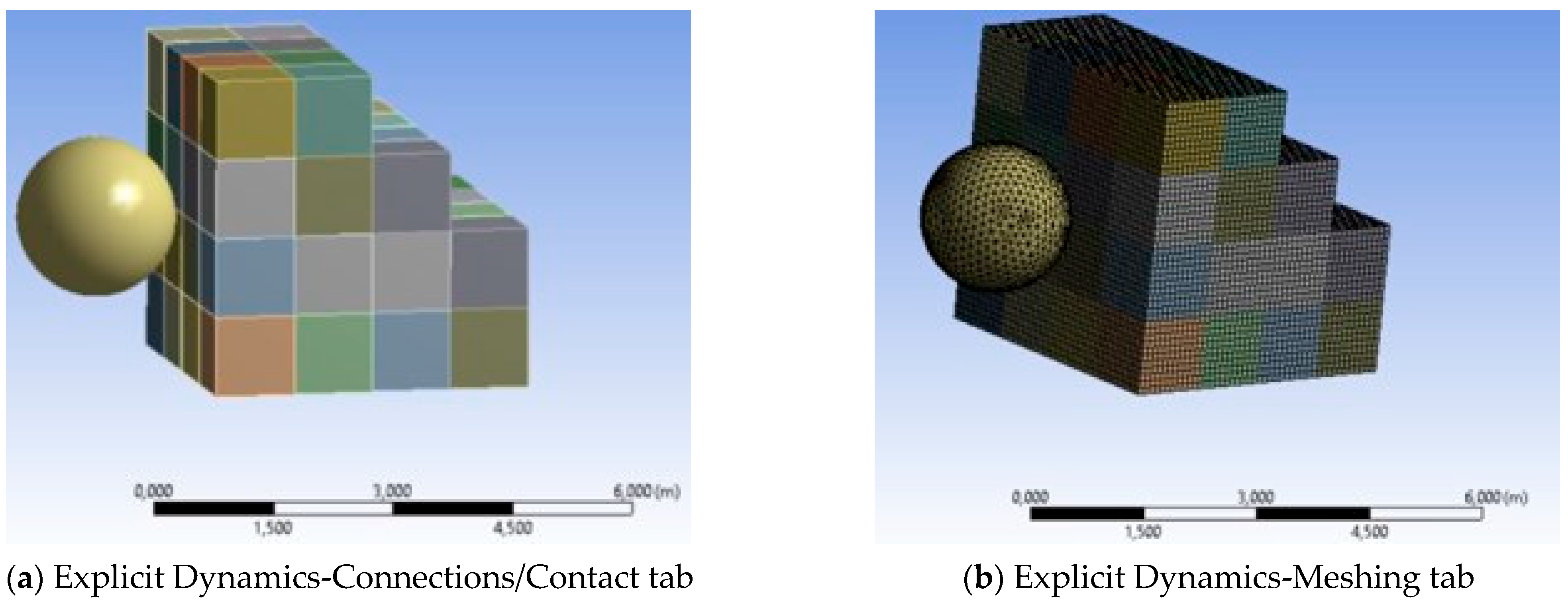
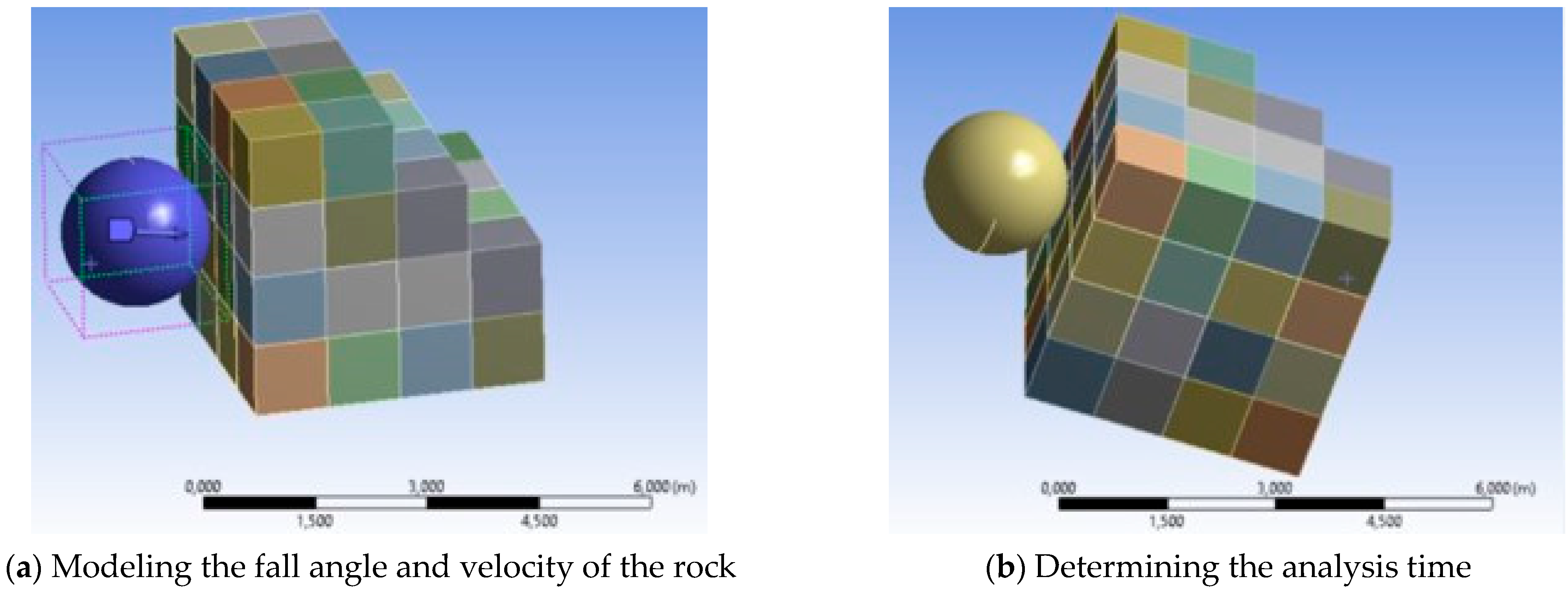
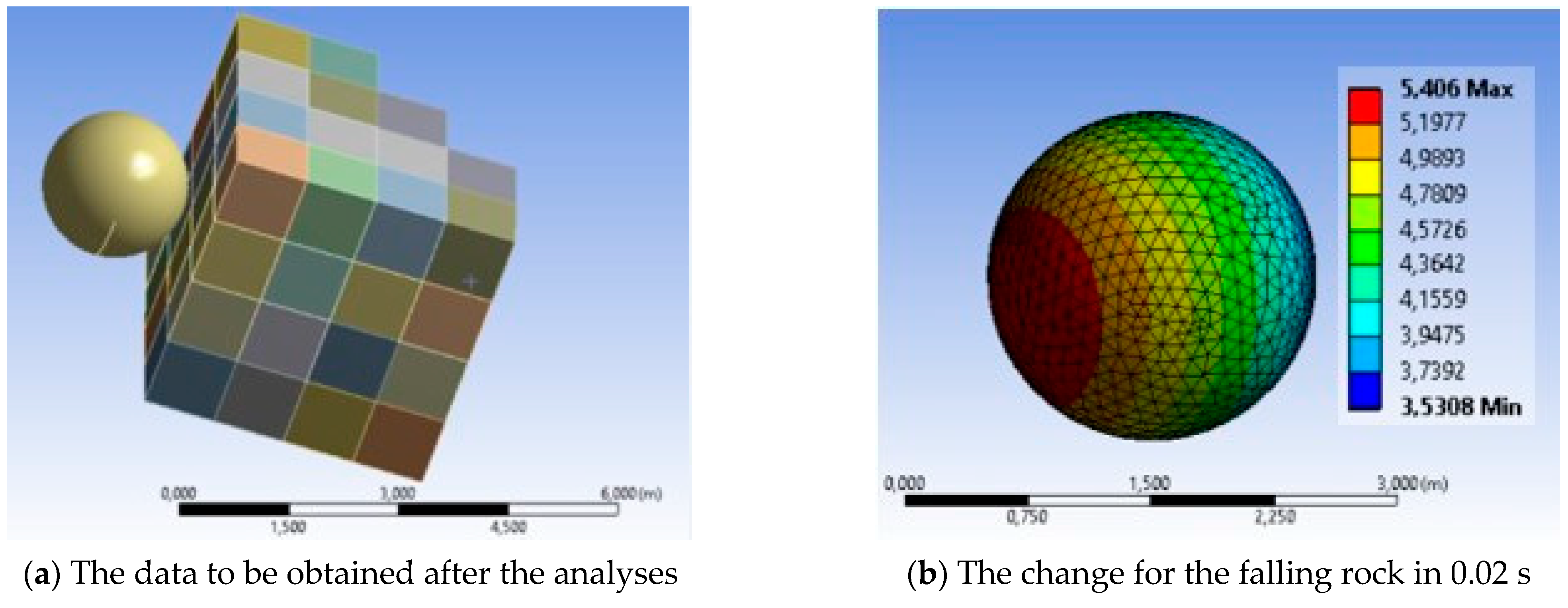


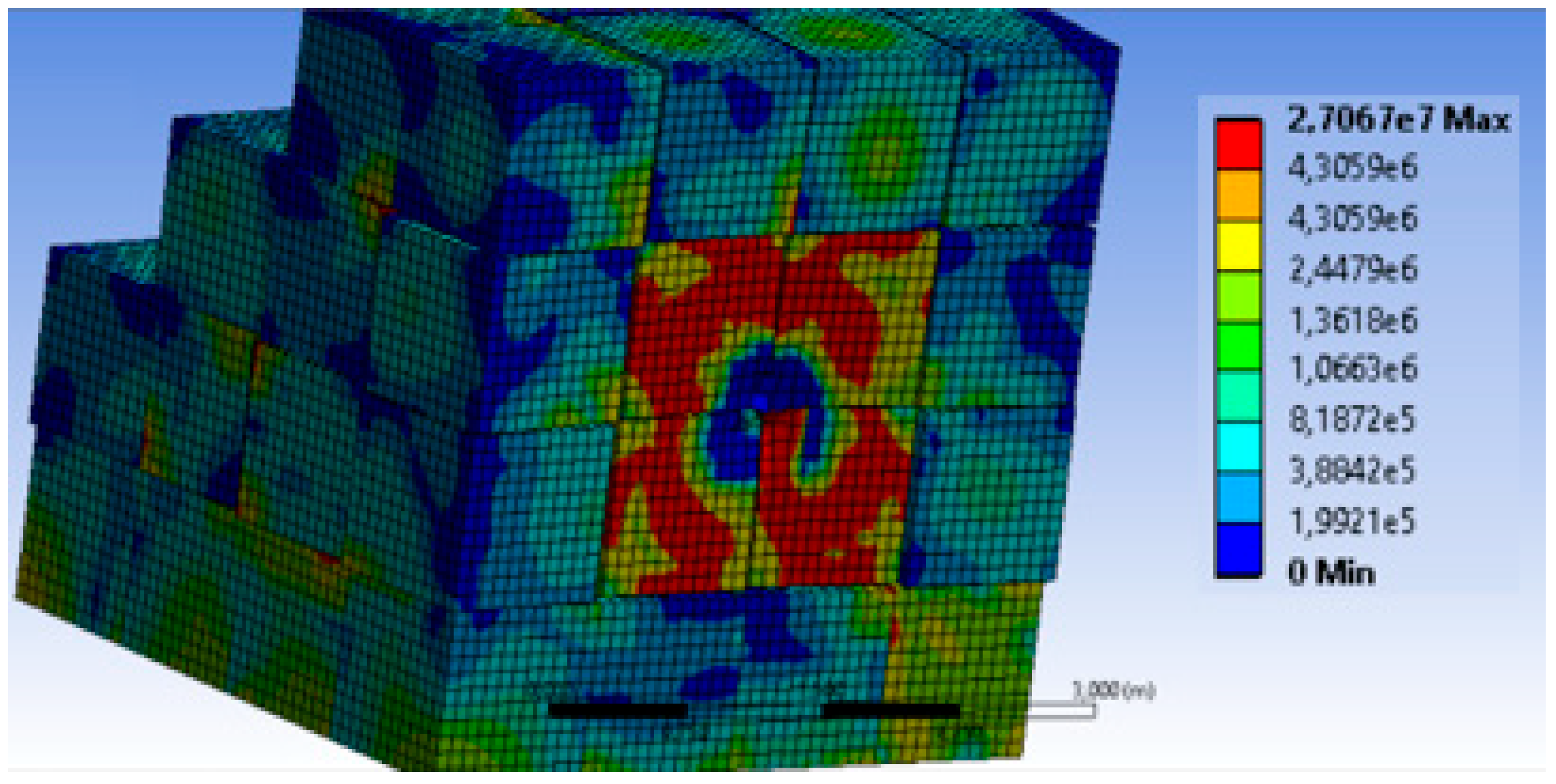
| Risk Class | Total Weighted Score 1–100 | Risk | Indicative Protection Measures (the Choice is Site Specific) |
|---|---|---|---|
| I | <20 | Very Low | Not necessary. May be sparse spot interventions. |
| II | 21–40 | Low | In limited extent |
| III | 41–60 | Medium | Light measures (such as bolts, nets, removal of unstable blocks, simple light fences) |
| IV | 61–80 | High | Combination of active (such as bolts, anchors) and passive (such as nets, wire rope cables, buttress walls, fences removal of unstable blocks) measures |
| V | 81–100 | Very High | Critical state of stability, combination of generalized or/and strong active and passive measures. Residual risk to be accepted. |
| Start | End | |||
|---|---|---|---|---|
| Gabion-1 | 656,692.882 | 4,300,284.94 | 656,762.246 | 4,300,297.08 |
| Gabion-2 | 656,686.813 | 4,300,261.53 | 656,536.814 | 4,300,307.48 |
| Gabion-3 | 656,555.022 | 4,300,286.67 | 656,357.336 | 4,300,428.87 |
| Gabion-4 | 656,232.481 | 4,300,568.46 | 656,387.682 | 4,300,437.54 |
| Gabion-5 | 656,229.013 | 4,300,687.25 | 656,330.457 | 4,300,591.87 |
| Discontinuity Spacing (m) | Nj (or Ks) |
|---|---|
| >3.0 | 0.40 |
| 3.0–0.9 | 0.25 |
| 0.9–0.3 | 0.1 |
| Input Parameters | Uniaxial Compressive Strength (σc) | Rock Quality Designation (% RQD) | |
|---|---|---|---|
| Value | 20 MPa | 30 | |
| Allowable bearing capacity (MPa) | Bishnoi (1968) | 2.0 MPa | |
| Peck vd. (1974) | 1.6 MPa | ||
| Age | Lithology | Density (gr/cm3) | Unit Weight (kN/m3) | Uniaxial Compressive Strength (MPa) | Point Load (MPa) |
|---|---|---|---|---|---|
| Middle Miocene | Dacite | 2.45–2.56 | 24.0–25.11 | 118 | 5.9–7.86 |
| Middle Miocene | Tuff | 2.14–2.30 | 21.1–22.56 | 20 | 1.1–1.3 |
Disclaimer/Publisher’s Note: The statements, opinions and data contained in all publications are solely those of the individual author(s) and contributor(s) and not of MDPI and/or the editor(s). MDPI and/or the editor(s) disclaim responsibility for any injury to people or property resulting from any ideas, methods, instructions or products referred to in the content. |
© 2024 by the authors. Licensee MDPI, Basel, Switzerland. This article is an open access article distributed under the terms and conditions of the Creative Commons Attribution (CC BY) license (https://creativecommons.org/licenses/by/4.0/).
Share and Cite
Angın, Z.; Karahasan, O.Ş. Evaluation of the Performance of Gabion Walls as a High-Energy Rockfall Protection System Using 3D Numerical Analysis: A Case Study. Appl. Sci. 2024, 14, 2360. https://doi.org/10.3390/app14062360
Angın Z, Karahasan OŞ. Evaluation of the Performance of Gabion Walls as a High-Energy Rockfall Protection System Using 3D Numerical Analysis: A Case Study. Applied Sciences. 2024; 14(6):2360. https://doi.org/10.3390/app14062360
Chicago/Turabian StyleAngın, Zekai, and Olguhan Şevket Karahasan. 2024. "Evaluation of the Performance of Gabion Walls as a High-Energy Rockfall Protection System Using 3D Numerical Analysis: A Case Study" Applied Sciences 14, no. 6: 2360. https://doi.org/10.3390/app14062360





